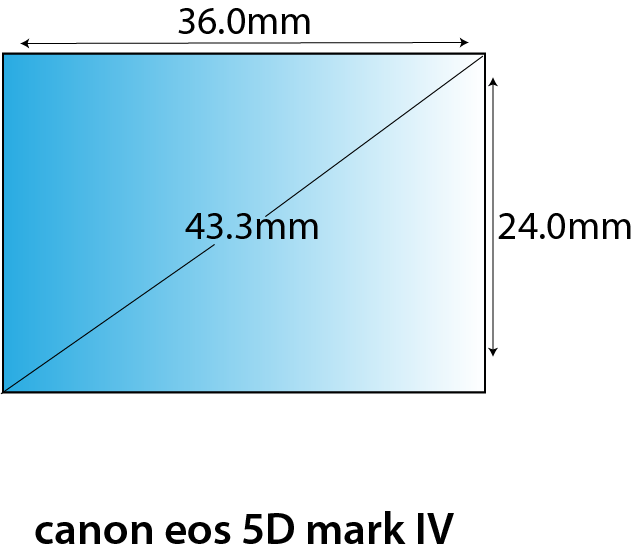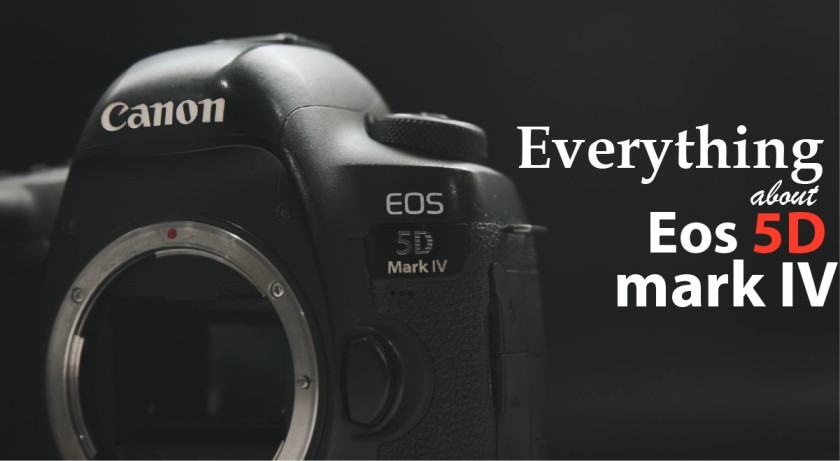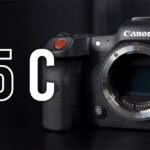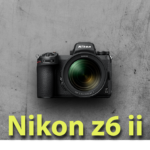The Canon 5D series continues to be popular among photographers when it comes to professional-grade cameras. With its excellent image quality, modern capabilities, and robust design, the Canon 5D Mark IV received a lot of attention.
in the camera accessories blog, we look at the Canon 5D Mark IV price in India and provide photography fans with more details on this excellent camera’s capabilities and pricing.
Features of the Canon EOS 5D Mark IV:

Canon’s EOS 5D family dates back to 2005 and has been successful thanks to a string of excellent Canon DSLRs. In short, the flagship, deep-bodied EOS-1 family and the full-frame EOS 5D series are a single step apart in features and technologies.
The EOS 5D series benefited from a more manageable, yet robust body, and placed a strong focus on image quality rather than extreme speed, which belonged more to the EOS-1 models.
| Sensor: | 36 x 24mm 30.4MP CMOS |
| Focal length conversion: | 1x (full-frame) |
| Memory: | One CompactFlash; one SD/SDHC/SDXC (UHS-I) |
| Viewfinder: | Optical pentaprism with approx. 100% coverage |
| Max video resolution: | 4K (4,096 x 2,160) at 30fps |
| ISO range: | 100-32,000 (50–102,400 expansion) |
| Autofocus points: | 61 points. Max of 41 cross-type AF points inc 5 dual cross-type at f/2.8 and 21 cross-type AF points at f/8. The quantity of cross-type AF points will vary dependent on the lens. |
| Max burst rate: | 7fps |
| Screen: | 3.2in Clear View II touchscreen LCD; approx. 1,620,000 dots |
| Shutter speeds: | 30-1/8,000 sec plus Bulb |
| Weight: | 890g |
| Dimensions: | 51 x 116 x 76mm |
| Power supply: | LP-E6N rechargeable lithium-ion battery. |
The EOS 5D Mark IV has proven to be an excellent photographic tool for photographers of all kinds, but it could turn out to be Canon’s last full-frame DSLR model. The camera existed long enough for an active user and second-hand market, but it remains available new.
Its strong, proportioned housing includes a full-frame CMOS sensor having a resolution of 30.4MP. Because of the camera’s processing capability, full-size Raw may be shot at 7 frames per second. With a 61-zone AF system, a native ISO range of 100 to 32,000, and an extendable range of 50 to 102,400. this camera can handle even the most demanding photographer’s requirements.
The 30.4-megapixel sensor will be discussed first. That made headlines in 2016. It didn’t quite compete with the 42MP Sony Alpha 7R II or the 36.3MP Nikon D810, but files still output at 6,720 x 4,480 pixels. This implies that the native size is a little under A2 at 56.9 x 37.9cm (22.4 x 14.9 inches) if you wish to print at 300 dpi.
The Canon 1D X Mark II and 80D both use the same sensor as the 5D Mark IV. The on-chip digital-to-analog conversion of this sensor, as stated by Canon, enhances noise efficiency and dynamic range. Also, using Dual Pixel Raw technology lets you adjust the sharpest part of an image during post-production (currently, only if using Canon’s own DPP software). has not gotten a lot of press and has since been surpassed by more glaring advances in camera quality.
The Mk IV has an extending native sensitivity range of ISO 100–32,000 and 50–102,400. The 61-point AF system with 41 cross-type sensors (five of which are dual cross-type for greater accuracy) is handled by the Digic 6+ CPU, which is utilized for everything else. The camera uses both a Digic 6 and a Digic 6+ processor.
Focusing shouldn’t be an issue in low light since the AF system is sensitive down to -3EV (-4EV in Live View), a value darker than moonlight. You may use lens/teleconverter combinations with a maximum aperture of f/8 and still get clear pictures. has not really gotten a lot of press and has since been surpassed by more glaring advances in camera quality.
Sports and wildlife photographers will also enjoy the ability to use lens/teleconverter combinations with the greatest aperture of f/8 and still have access to all 61 AF points (21 cross-type).
Dual Pixel Raw review of the Canon EOS 5D Mark IV

The Canon Rebel EOS 5D Mark IV’s new Dual Pixel Raw feature makes use of both of the camera’s 30.4-million-pixel sensor’s photodiodes. A single raw file will be saved as two images during Dual Pixel raw photography.
The second picture is made to record image data from just one set of photodiodes, whereas one image consists of image data from both photodiodes. This means that in addition to a normal image, Dual Pixel Raw files also contain parallax information that may be assessed to infer subject distance.
The main menu’s img_0189 Dual Pixel Raw entry is only accessible when the picture quality is set to raw. The main menu’s img_0189 Dual Pixel Raw entry is only accessible when the picture quality is set to raw
Sensor Performance of eos 5D mark IV

A magnificent 30.4-megapixel full-frame CMOS sensor is included in the 5D Mark IV. It is unique from the 5D Mark III, which many users both then and still liked. But if a high-resolution sensor doesn’t have a bit that corresponds to depth and dynamic range, what good is it? Fortunately, the Canon 5D Mark IV excels with both: a 13.6 EVF dynamic range and 24.8-bit color depth. I have no issues shooting underexposed or overexposed photos to bring out the shadow detail.
You may almost forget that something is over- or underexposed as long as the camera is set to raw. I have the propensity to photograph a bit overexposed; however, the image gets restored to normal in post-production to correct skin tones. I have an impulse to photograph a bit overexposed; however, the image gets restored to normal in post-production to fix skin tones.
The ISO range of the Canon 5D Mark IV is an additional significant benefit. The range is ISO 100 to 32,000. The highest setting that I can use is ISO 12,800. If you’re shooting at an elevation greater than that, you’re either photographing in the dark or astrophotography, or you’re doing something truly wrong. I’ve used it to shoot my late event work, and not a single client ever complained that the pictures are too grainy.
If anything, I enjoy giving them additional texture and a more film-like aspect by adding grain in post-production. The Canon 5D Mark IV sensor is fantastic for images, and you won’t encounter any problems with 99% of your work on it. For the past ten years, the requirements for producing high-level campaigns remain constant. Without significant cropping, you could possibly get by with a 21-megapixel Canon 5D Mark II.
Focusing
Focusing on the 5D Mark IV isn’t awful either, despite not being as excellent as Canon’s flagship cameras. Although the live view focus is passable, I hardly ever use it because of the way I photograph. Although the focusing technology won’t be quite as excellent as those in current cameras, it will still be functional. With enhanced facial tracking and recognition, the focusing system of the Canon 5D Mark IV is based on the previous Canon 1D X model. Both your lens and camera have a role in focusing. The Canon 5D Mark IV generally works well for portrait, fashion, and beauty photography in my opinion. It isn’t even close to being as horrible as the one on the Canon 5Ds. When I am aware of the situation, I will shoot will be fast-moving, I always switch to the 5D Mark IV.
Permanent Durability
This is an important problem for me and other photographers who don’t frequently upgrade their equipment. A camera is a costly piece of equipment, therefore purchasing one should be a long-term decision. So, let’s discuss how reliable the Canon 5D Mark IV has proven over time.
On set, I had an imaging break, and it was barely short of the 150k shutter obstacle. At first, I had some concerns about the camera’s reliability because of this. I decided to purchase it used, which is usually a risk. Maybe the previous owner wasn’t as careful with it, or perhaps I was too careless with it; the latter is more probable. Anyhow, after fixing this camera, it’s Anyway, after being fixed, the camera is back on set and working better than before.
It has been dropped many times, its bottom has crashed on the tripod base, and water has splashed all over it. I can attest that this is a worker of a camera and that it will continuously serve you for years. If it does fail, you can simply replace the shutter and have a brand-new camera. Batteries’ dependability is a further argument I must make.
Although the battery’s production date is 2016, I can still get 800 pictures out of the camera. I very rarely, if ever, stress over lacking enough battery life for a day of nonstop photography.
Canon 5d mark iv Strong & Weaknesses & their performance
However, the camera has several shortcomings. One of the most obvious ones is that it is a DSLR, which is considered antiquated equipment by modern marketing standards.
| Timing and Performance |
|---|
| performance that is excellent for its class. |
| Power on during start-up/play to record and the first shot |
| The duration it takes to switch on and take a picture is 0.5 seconds. |
Though acceptable, the footage is not the greatest that is currently available. I almost ever use it for video work since the 4K on it is, to put it mildly, pretty disappointing. So, if you are a videographer, avoid using this camera. For those of us who favor live-view photography, the back-LCD’s lack of articulation can be a concern.
| first shot, record to playback |
|---|
| 0.2 seconds pass before the first picture is taken. |
| For a DSLR, the time from turning on and shooting a picture was roughly half a second. A picture was snapped and the playback to the Record mode switch took place in less than 0.2 seconds. |
| Shutter Response (Lag Time) | ||
|---|---|---|
| Optical Viewfinder | ||
| Single-point, full autofocus (in the middle) AF | The duration from completely pressing the shutter button to image capture is 0.165 seconds. Canon 50mm f/1.8 STM lens utilised for all AF time tests. | |
| Set full autofocus single-point AF TTL flash | N/A | Allow the flash to fire as you take the photograph. The camera’s shutter response can be slowed by the flash’s pre-flash metering pulses. |
| Hands-On Focus | 0.077 sec. | While shutter delay is often longer when employing manual focus versus autofocus, it is usually faster if the camera is “prefocused” |
| Pre-focused | 0.057 sec. | After half of pressing and holding the shutter button, it is time for an image. |
| Live View | ||
| Prefocused Live View in Live View | 0.057 sec. | After half-pushing pressing and holding the shutter button, it is time for a picture. |
The Canon 5D IV displayed an acceptable complete autofocus shutter response for an expert DSLR when it was finally established that it was focused when shooting the same subject continuously (without adjusting the focus setting between repetitions, to remove the influence of lens AF speed).
We documented 0.165 seconds for the entire AF lag using single point (center) AF, which is fairly quick when using the optical viewfinder with a Canon 50mm f/1.8 STM lens (a lens that may not be fast at actually changing focus but is very fast at focus determination).
Using manual focus, the shutter delay was equally acceptable at 77 milliseconds. The shutter delay of the 5D IV was a mere 57 milliseconds whereas “prefocusing” the camera by half-pressing holding down the shutter button before the end of exposures.
In Live View mode, the Canon 5D IV also has a prefocused shutters lag time of just 57 milliseconds, which is very quick for a DSLR. Take note that we no longer determine finish AF lag in DSLR Live View mode because the lens used usually causes a difference so significant that the comparison is pointless. In our shooter’s report, we’ll try to say on real Live View AF performance.
We evaluate the AF-active shutter lag with the lens already set to the right focal distance in order to reduce the impact of different lenses’ focusing speeds.
| Shot-to-shot cycle time | |
| Single Shot setting JPEG, Large/Fine | The time each shot averaged across several frames, was 0.37 seconds. |
| Single Shot setting JPEG + L/F + RAW | The time each shot averaged across several frames, was 0.37 seconds. |
| Premature shutter fine? | The ideal response is “No” since certain cameras won’t take another picture if you release and push the shutter too rapidly when in Single Shot mode. |
| High-quality, continuous large/fine JPEG | Time each shot averaged across 174 shots with no symptoms of slowing down, was 0.14 seconds (7.0 frames per second); infinite frames; and 2 seconds to clear* (we’ll call that unlimited). |
| Continuous High RAW | The time for every frame was 0.14 seconds (7.0 frames per second); 19 frames overall; 5 seconds to clear*; whereas the buffer was full, the time per shot was 0.36 minutes or 2.8 frames per second. |
| Continuous High RAW plus L/F JPEG | Time each shot averaged across a 12-shot buffer capacity, dropped to an average of 0.71 seconds or 1.4 frames per second when the buffer was full, and was 0.14 seconds (7.0 frames per second); 12 frames total; 8 seconds to clear. |
| Dual High Continuous Pixel RAW | Time for every frame averaged over a 7-shot buffering period slowed to an average of 0.69 seconds or 1.5 frames per second when the buffer was full, and it was 0.20 seconds (5.0 frames per second), 7 frames in general, and 4 seconds to clear. |
| RAW + L/F JPEG at Continuous High Dual Pixel | Time for every frame averaged over a 6 shot buffer capacity, slowed to an average of 0.84 seconds or 1.2 frames per second once the buffer was full, which was 0.24 seconds (4.2 frames per second), 6 frames in general, then 5 seconds to clear. |
| immediate recycling | Flash output at greatest is N/A. |
Cycle times and burst mode performance can also be affected by ISO sensitivity and noise reduction settings.
Single-shot cycle times for the best quality JPEGs and RAW+JPEG files were under a second. (Note that we no longer assess single-shot mode with just RAW files since the outcomes typically fall between JPEG and RAW+JPEG modes.)
As a high-res full-frame DSLR, full-resolution continuous high-mode speeds were outstanding. No matter the file type, we captured 7.0 frames per second, which is in accordance with Canon’s guidelines. Canon charges the 5D IV’s low-speed and silent nonstop shooting modes at 3.0 frames per second, while we did not test those situations in the lab.
*Note: Clearing timings for the buffer were calculated using a 64GB Lexar Professional 1066x UDMA 7 CompactFlash card. Clearing times may be affected by the speed of the cards. The length of bursts in continuous mode may also be limited by slow cards.
With our fast Lexar 1066x UDMA 7 CompactFlash card, buffer depth for the finest JPEGs looked to be infinite. The buffer depth when the camera slowed down was 19 frames while shooting typical RAW files and 12 frames when shooting RAW+JPEG.
(Note: The CompactFlash card we used for our tests is more quickly than the quickest UHS-I card available; the Canon 5D IV additionally accepts SD cards but does not allow faster UHS-II versions.)
The camera’s interface allows you to change settings or use additional shots while clearing, but you cannot view recent photos during buffer clearing. Buffer clearing times were quite good considering the resolution, ranging from only 2 seconds after 174 best-quality JPEGs to 8 seconds after a burst of 12 RAW+JPEG frames.
The Canon 5D IV slows down with smaller buffer depths while shooting in Dual Pixel RAW mode, and this is understandable considering the significantly greater file sizes. While buffer depths decreased to 7 and 6 frames, respectively, the camera was able to capture Dual Pixel RAW frames in continuous high mode at approximately 5.0 fps and Dual Pixel RAW+JPEG frames at 4.2 fps.
Pros
- high-quality RAW files for images; greater dynamic range; outstanding performance at high ISO; a quick 7 fps bursting rate and an endless JPEG buffer; superb 4K cinematic video; Integrated Wi-Fi; The dual pixel CMOS AF is amazing.
Cons
- Default JPEG settings provide soft images; 1/200s flash sync; a difficult 4K video codec; Limit for nonstop video recording: 29:59
is canon 5d mark iv Netflix approved?
Netflix refused to allow the Sony A7s II, Canon 5d Mark IV, or other similar video cameras. None of the other 4K mirrorless cameras, such as the Sony A7S II, have been included on the list. The A7 cameras’ 8bit 4:2:0 at just 100Mbit just cannot compete in the same top movie category.
canon 5d mark iv price in India
Expert photographers and photographic lovers who seek excellent image quality, innovative abilities, and durability continue to favor the Canon 5D Mark IV.
While the camera’s cost may vary in the nation of India, it is usually thought of as a big investment. The price for a Canon EOS 5D Mark IV 30.4MP DSLR camera in India is 267,040. On June 21, 2023, Flipkart will have the Canon EOS 5D Mark IV 30.4MP DSLR Camera at the lowest price of 267,040. This is the price of Canon 5d mark iv price in India.
The Canon 5D Mark IV is a camera to take if you’re passionate about photography and prepared to spend money on a high-end model.
ALSO READ: The newly launched canon powershot v10!!!




